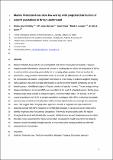Marine protected areas show low overlap with projected distributions of seabird populations in Britain and Ireland
Abstract
Marine Protected Areas (MPAs) are an important tool for the conservation of seabirds. However, mapping seabird distributions using at-sea surveys or tracking data to inform the designation of MPAs is costly and time-consuming, particularly for far-ranging pelagic species. Here we explore the potential for using predictive distribution models to examine the effectiveness of current MPAs for the conservation of seabirds, using Britain and Ireland as a case study. A distance-weighted foraging radius approach was used to project distributions at sea for an entire seabird community during the breeding season, identifying hotspots of highest density and species richness. The percentage overlap between distributions at sea and MPAs was calculated at the level of individual species, family group, foraging range group (coastal or pelagic foragers), and conservation status. On average, 32.5% of coastal populations and 13.2% of pelagic populations overlapped with MPAs indicating that pelagic species, many of which are threatened, are likely to have significantly less coverage from protected areas. We suggest that a foraging radius approach provides a pragmatic and rapid method of assessing overlap with MPA networks for central place foragers. It can also act as an initial tool to identify important areas for potential designation. This would be particularly useful for regions throughout the world with limited data on seabird distributions at sea and limited resources to collect this data. Future assessment for marine conservation management should account for the disparity between coastal and pelagic foraging species to ensure that wider-ranging seabirds are afforded adequate levels of protection.
Citation
Critchley , E J , Grecian , W J , Kane , A , Jessopp , M J & Quinn , J L 2018 , ' Marine protected areas show low overlap with projected distributions of seabird populations in Britain and Ireland ' , Biological Conservation , vol. 224 , pp. 309-317 . https://doi.org/10.1016/j.biocon.2018.06.007
Publication
Biological Conservation
Status
Peer reviewed
ISSN
0006-3207Type
Journal article
Description
EJC was funded by the Irish Petroleum Infrastructure Programme (PIP) IS013/08. WJG was funded by INSITE http://www.insitenorthsea.org/. AK was funded by the Irish Research CouncilGOIPD/2015/81. MJ was funded by the SFI Centre for Marine and Renewable Energy (12/RC/2302).Collections
Items in the St Andrews Research Repository are protected by copyright, with all rights reserved, unless otherwise indicated.

